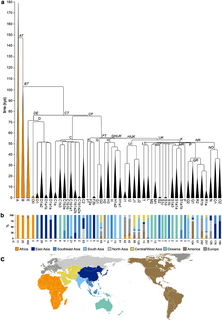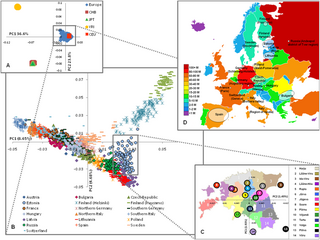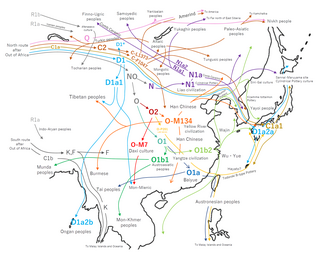Related Research Articles
The history of the Comoros extends to about 800–1000 AD when the archipelago was first inhabited. The Comoros have been inhabited by various groups throughout this time. France colonised the islands in the 19th century, and they became independent in 1975.

The Bantu expansion is a hypothesis of major series of migrations of the original Proto-Bantu-speaking group, which spread from an original nucleus around West-Central Africa across much of sub-Saharan Africa. In the process, the Proto-Bantu-speaking settlers displaced or absorbed pre-existing hunter-gatherer and pastoralist groups that they encountered.

The Siddi, also known as the Sheedi, Sidi, or Siddhi, are an ethnic group inhabiting India and Pakistan. They are primarily descended from the Bantu peoples of the Zanj coast in Southeast Africa, who were merchants, sailors, indentured servants, slaves and mercenaries. The Siddi population is currently estimated at around 850,000 individuals, with Karnataka, Gujarat and Hyderabad in India and Makran and Karachi in Pakistan serving as the main population centres. Siddis are primarily Muslims, although some are Hindus and others belong to the Catholic Church.
Afro-Asians, African Asians or simply Black Asians, often referred to as Blasians, are persons of mixed Asian and African ancestry. Historically, Afro-Asian populations have been marginalised as a result of human migration and social conflict.
The Swahili people comprise mainly Bantu, Afro-Arab and Comorian ethnic groups inhabiting the Swahili coast, an area encompassing the Zanzibar archipelago and mainland Tanzania's seaboard, littoral Kenya, northern Mozambique, the Comoros Islands, southwestern Somalia and Northwest Madagascar. The original Swahili distinguished themselves from other Bantu peoples by self-identifying as Waungwana. In certain regions, this differentiation is even more stratified in terms of societal grouping and dialect, hinting to the historical processes by which the Swahili have coalesced over time. More recently however, Swahili identity extends to any person of African descent who speaks Swahili as their first language, is Muslim and lives in a town on the main urban centres of most of modern-day Tanzania and coastal Kenya, northern Mozambique and the Comoros, through a process of swahilization.
Haplogroup F is a human mitochondrial DNA (mtDNA) haplogroup. The clade is most common in East Asia and Southeast Asia. It has not been found among Native Americans.

Haplogroup L3 is a human mitochondrial DNA (mtDNA) haplogroup. The clade has played a pivotal role in the early dispersal of anatomically modern humans.
Haplogroup K or K-M9 is a human Y-chromosome DNA haplogroup. A sublineage of haplogroup IJK, K-M9, and its descendant clades represent a geographically widespread and diverse haplogroup. The lineages have long been found among males on every continent except Antarctica.

In human genetics, a human Y-chromosome DNA haplogroup is a haplogroup defined by mutations in the non-recombining portions of DNA from the male-specific Y chromosome. Many people within a haplogroup share similar numbers of short tandem repeats (STRs) and types of mutations called single-nucleotide polymorphisms (SNPs).

The Genetic history of Europe deals with the formation, ethnogenesis, and other DNA-specific information about populations indigenous, or living in Europe.

The genetic history of the Middle East is the subject of research within the fields of human population genomics, Archaeogenetics and Middle Eastern studies. Researchers use Y-DNA, mtDNA, and other autosomal DNAs to identify the genetic history of ancient and modern populations of Egypt, Persia, Mesopotamia, Anatolia, Arabia, the Levant, and other areas.
Haplogroup E-M75 is a human Y-chromosome DNA haplogroup. Along with haplogroup E-P147, it is one of the two main branches of the older haplogroup E-M96.

African admixture in Europe refers to the presence of admixture events attributable to dispersal of populations inhabiting Africa in the genetic history of Europe. Certain Y-DNA and mtDNA lineages are thought to have spread from Northeastern Africa to the Near East during the later Pleistocene, and from there to Europe with the Neolithic Revolution. More recent, direct African admixture – primarily Berber admixture from North Africa – is associated with the Carthaginian period as well as Muslim conquests of the Early Middle Ages, and is primarily concentrated in the Iberian peninsula, averaging from ~11% in the south and west to ~3% in the northeast, dropping to close to 0% in a cluster found in the Basque region. North African admixture has also been detected in the island of Sicily.

In human mitochondrial genetics, L is the mitochondrial DNA macro-haplogroup that is at the root of the anatomically modern human mtDNA phylogenetic tree. As such, it represents the most ancestral mitochondrial lineage of all currently living modern humans, also dubbed "Mitochondrial Eve".
Genetic studies on Jews are part of the population genetics discipline and are used to analyze the chronology of Jewish migration provided by research in other fields, such as history, linguistics, archaeology, and paleontology. These studies investigate the origins of various Jewish populations today. In particular, they investigate whether there is a common genetic heritage among various Jewish ethnic divisions.
The Shirazi people, also known as Mbwera, are a Bantu ethnic group inhabiting the Swahili coast and the nearby Indian ocean islands. They are particularly concentrated on the islands of Zanzibar, Pemba and Comoros.
The proportions of various human Y-DNA haplogroups vary significantly from one ethnic or language group to another in Africa.

The tables below provide statistics on the human Y-chromosome DNA haplogroups most commonly found among ethnolinguistic groups and populations from East and South-East Asia.
Research into the predominant human Y-DNA haplogroups of Central Asia and North Asia, broken down according to both individual publications and ethnolinguistic groups, are summarized in the table below.

The genetic history of the African diaspora is composed of the overall genetic history of the African diaspora, within regions outside of Africa, such as North America, Central America, the Caribbean, South America, Europe, Asia, and Australia; this includes the genetic histories of African Americans, Afro-Canadians, Afro-Caribbeans, Afro-Latinos, Afro-Europeans, Afro-Asians, and African Australians.
References
- ↑ Tanzania Ethnic Groups, East Africa Living Encyclopedia, accessed 28 June 2010
- ↑ Ari Nave (2010). Anthony Appiah; Henry Louis Gates (eds.). Encyclopedia of Africa. Oxford University Press. pp. 187–188. ISBN 978-0-19-533770-9.
- ↑ Ari Nave (2010). Anthony Appiah; Henry Louis Gates (eds.). Encyclopedia of Africa. Oxford University Press. p. 379. ISBN 978-0-19-533770-9.
Most scholars, however, believe that the Shirazi actually began their settlement of the East African coast in the twelfth century and that they originated in Somalia. Shirazi established themselves on the following islands: Lamu Kenya, Pemba Zanzibar, Mafia and Kilqa Kiswani all in Tanzania and Comoros. (...) Known for their mercantile skills, the Shirazi asserted themselves as ruling elites as early as the twelfth century on the islands that were their base. Trade in gold, ivory and slaves brought prosperity to the Shirazi
- ↑ August H. Nimtz (1980). Islam and Politics in East Africa. University of Minnesota Press. pp. 3–11, 30–33, 39–47. ISBN 978-0-8166-0963-5., Quote: "The Shirazi were classified as native, that is, Africans, and this they were of low status. Prior to the colonial era, the Shirazi and Arabs saw themselves, for the most part, as one community. (...) Unlike the previous periods in which African captives were usually taken to Persian Gulf areas to work primarily as domestic laborers, by the nineteenth century, most slaves were being utilized on the vast clove and plantations on the East African coast and offshore islands. (...) Arab rule, from this period until its demise at the hands of the European powers, became virtually synonymous with slavery and slave ownership." (...) "Though Shirazi ownership of slaves was never as extensive as the Arabs, slaves were a major source of their wealth"
- ↑ Per O. Hernæs, Tore Iversen (2002). Slavery Across Time and Space: Studies in Slavery in Medieval Europe and Africa. University of Virginia. p. 23. ISBN 8277650418 . Retrieved 28 November 2016.
- 1 2 3 4 Msaidie, Said; et al. (2011). "Genetic diversity on the Comoros Islands shows early seafaring as major determinant of human biocultural evolution in the Western Indian Ocean" (PDF). European Journal of Human Genetics. 19 (1): 89–94. doi:10.1038/ejhg.2010.128. PMC 3039498 . PMID 20700146.
We reveal the Comoros population to be a genetic mosaic, the result of tripartite gene flow from the North, the East and the West. Admixture analysis of the maternal and paternal contributions indicates the gene pool to be predominately African (72%), with significant contributions from Western Asia (17%) and Southeast Asia (11%). Our study therefore provides the first unequivocal evidence that the Middle Eastern trade routes that developed along the East African coast, during the last 2 000 years, have left a genetic trace. (...) This concords withhistorical data which attests to the presence of traders from Shiraz in Iran on the Comoros, and also the Comorian's own oral traditions which recount that Shirazi princes came in ships and established colonies on the islands. On the island of Anjouan the term "Shirazi" is used to refer to someone of Middle Eastern appearance. There is historical evidence that 1 000 YBP Persian traders played an important role in trade along the East coast, and we therefore predict that an Iranian genetic signal will be detected among Swahili speakers at former Middle Eastern trading centres on the sub-Saharan East coast, such as the islands of Zanzibar and Kilwa off the coast of Tanzania. (...)
- ↑ Msaidie, Said; et al. (2011). "Genetic diversity on the Comoros Islands shows early seafaring as major determinant of human biocultural evolution in the Western Indian Ocean" (PDF). European Journal of Human Genetics. 19 (1): 89–94. doi:10.1038/ejhg.2010.128. PMC 3039498 . PMID 20700146.
This concords with historical data which attests to the presence of traders from Shiraz in Iran on the Comoros, and also the Comorian's own oral traditions which recount that Shirazi princes came in ships and established colonies on the islands.